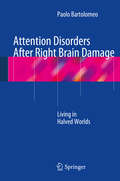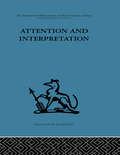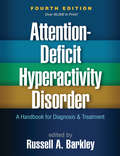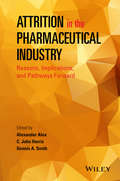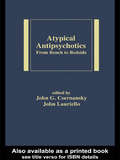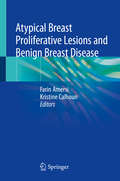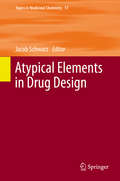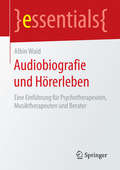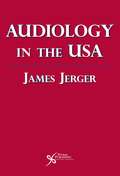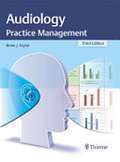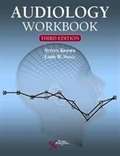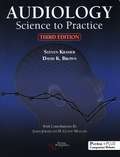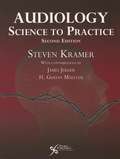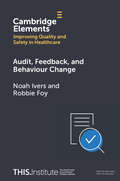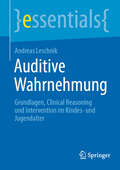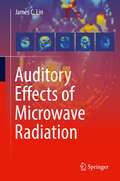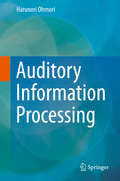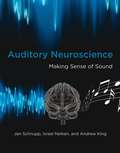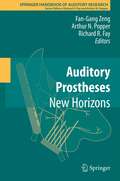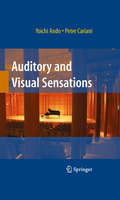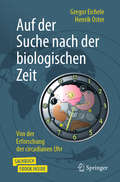- Table View
- List View
Attention Disorders After Right Brain Damage: Living in Halved Worlds
by Paolo BartolomeoThis book provides an overview of attentional impairments in brain-damaged patients from both clinical and neuroscientific perspectives, and aims to offer a comprehensive, succinct treatment of these topics useful to both clinicians and scholars. A main focus of the book concerns left visual neglect, a dramatic but often overlooked consequence of right hemisphere damage, usually of vascular origin, but also resulting from other causes such as neurodegenerative conditions. The study of neglect offers a key to understand the brain's functioning at the level of large-scale networks, and not only based on discrete anatomical structures. Patients are often unaware of their deficits (anosognosia), and often obstinately deny being hemiplegic. Diagnosis is important because neglect predicts poor functional outcome in stroke. Moreover, effective rehabilitation strategies are available, and there are promising possibilities for pharmacological treatments. Attention Disorders After Right Brain Damage is aimed at clinical neurologists, medics in physical medicine and rehabilitation, clinical psychologists and neuropsychologists. It will also be useful for graduate students and medical students who wish to understand the topic of attention systems and improve their knowledge of the neurocognitive mechanisms of attentional deficits. In addition, clinical researchers in neuropsychology and cognitive neuroscience will find in this book an up to date overview of current research dealing with the attention systems of the human brain.
Attention and Interpretation: A scientific approach to insight in psycho-analysis and groups
by W R BionTavistock Press was established as a co-operative venture between the Tavistock Institute and Routledge & Kegan Paul (RKP) in the 1950s to produce a series of major contributions across the social sciences. This volume is part of a 2001 reissue of a selection of those important works which have since gone out of print, or are difficult to locate. Published by Routledge, 112 volumes in total are being brought together under the name The International Behavioural and Social Sciences Library: Classics from the Tavistock Press. Reproduced here in facsimile, this volume was originally published in 1970 and is available individually. The collection is also available in a number of themed mini-sets of between 5 and 13 volumes, or as a complete collection.
Attention-Deficit Hyperactivity Disorder, Fourth Edition: A Handbook for Diagnosis and Treatment
by Russell A. BarkleyWidely regarded as the standard clinical reference, this volume provides the best current knowledge about attention-deficit/hyperactivity disorder (ADHD) in children, adolescents, and adults. The field's leading authorities address all aspects of assessment, diagnosis, and treatment, including psychological therapies and pharmacotherapy. Core components of ADHD are elucidated. The volume explores the impact of the disorder across a wide range of functional domains--behavior, learning, psychological adjustment, school and vocational outcomes, and health. All chapters conclude with user-friendly Key Clinical Points. New to This Edition *Reflects significant advances in research and clinical practice. *Expanded with many new authors and new topics. *Chapters on cutting-edge interventions: social skills training, dietary management, executive function training, driving risk interventions, complementary/alternative medicine, and therapies for adults. *Chapters on the nature of the disorder: neuropsychological aspects, emotional dysregulation, peer relationships, child- and adult-specific domains of impairment, sluggish cognitive tempo, and more.
Attention-Deficit Hyperactivity Disorder, Third Edition
by Russell BarkleyThis handbook presents extensive knowledge on the nature, diagnosis, assessment, and treatment of ADHD. Provided are authoritative guidelines for understanding and managing the challenges ADHD poses to children, adolescents, and adults in a range of settings. All chapters conclude with user-friendly Key Clinical Points. Note Practitioners wishing to implement the assessment and treatment recommendations in the Handbook are advised to purchase the companion Workbook, which contains a full set of forms, questionnaires, and handouts, in a large-size format with permission to photocopy.
Attrition in the Pharmaceutical Industry
by C. John Harris Alexander Alex Dennis A. SmithWith a focus on case studies of R&D programs in a variety of disease areas, the book highlights fundamental productivity issues the pharmaceutical industry has been facing and explores potential ways of improving research effectiveness and efficiency. * Takes a comprehensive and holistic approach to the problems and potential solutions to drug compound attrition* Tackles a problem that adds billions of dollars to drug development programs and health care costs* Guides discovery and development scientists through R&D stages, teaching requirements and reasons why drugs can fail* Discusses potential ways forward utilizing new approaches and opportunities to reduce attrition
Atypical Antipsychotics: From Bench to Bedside (Medical Psychiatry Ser. #28)
by John G. Csernansky John LaurielloShowcasing the latest studies in the field, this reference unveils recent breakthroughs in the use of atypical antipsychotics for the treatment of a variety of patient populations-tracking developments in the management of patients with schizophrenia and affective psychotic disorders, as well as therapeutic regimens for children and adolescents.
Atypical Breast Proliferative Lesions and Benign Breast Disease
by Farin Amersi Kristine CalhounManagement of atypical breast lesions continues to evolve. There is considerable controversy as to whether these entities represent risk factors for future breast cancer or whether they are instead precursor lesions. A better understanding of the prognostic and therapeutic implications of each of these lesions is important for assessing subsequent breast cancer risk. Risk assessment tools are available for screening high risk patients and understanding the utility and limitations of these tools is important for all clinicians involved in the care of patients. There have been significant advances in breast cancer screening in the last several year including breast tomosynthesis, automated breast ultrasound, molecular imaging, as well as accelerated breast MRI protocols. This has raised the question: Do women at risk for breast cancer need additional breast cancer screening using these newer imaging modalities? In addition, with these advances in imaging, can women with atypical proliferative lesions be observed rather than undergoing surgical excision as some suggest? The role of observation, surgical excision and even prophylactic mastectomy in women with atypical proliferative lesions continues to be debated; however there is data that can guide physicians in the management of these patients. Pleomorphic Lobular carcinoma in-situ (PLCIS) is a distinct pathological entity within LCIS and there is no consensus regarding surgical margins or the need for adjuvant treatment to prevent recurrence. Recently, ductal carcinoma in-situ (DCIS) has been the subject of much controversy: is it truly a cancer or is it instead a precursor lesion. The traditional management of DCIS with lumpectomy and radiation is now being debated and recent data demonstrates that low grade DCIS can be managed with observation. Clinical trials are now accruing patients with low and intermediate grade DCIS to observation and close surveillance, and not surgical excision. Finally, new guidelines for chemoprevention with the use of tamoxifen and raloxifen for women with atypical proliferative lesions, LCIS, PLCIS, and DCIS are available and should be discussed as an option when guiding management of these patients. This book will provide a comprehensive review of this field and will serve as a valuable resource for clinicians, general surgeons, breast surgeons and surgical oncologists, as well as researchers with an interest in the management of atypical breast lesions. The book will review new data about breast cancer, risk factors for breast cancer, pathological features unique to each entity, the characteristic findings on imaging, risk stratification for genetic testing, as well as the current evidence-based management of each of these breast lesions. Our text will provide assessment tools for risk prediction of breast cancer. We will provide data on the current imaging modalities, as well as advanced screening options available for diagnosis and following these patients. Current management of many of these lesions continues to be controversial in regard to observation with close surveillance versus the need for surgical excision of these lesions based on future risk or whether these lesions are precursor lesion. For ductal carcinoma in-situ, the debate continues in regards to whether this disease entity is a precursor lesion that can be managed with observation or hormonal therapy, or is DCIS cancer and treated with lumpectomy and radiation. Several studies have been published where patients are managed with observation and treatment with hormonal therapy before surgical management. New trials have already begun accruing patients with low to intermediate grade DCIS where patients will be managed with observation versus hormonal therapy only. Management of DCIS continues to evolve and current management will be discussed This text will provide a concise but comprehensive summary of the current management of patients with atypical breast proliferative lesions and some benign breast lesions and will help guided management of these
Atypical Elements in Drug Design (Topics in Medicinal Chemistry #17)
by Jacob SchwarzMedicinal chemistry is both science and art. The science of medicinal chemistry offers mankind one of its best hopes for improving the quality of life. The art of medicinal chemistry continues to challenge its practitioners with the need for both intuition and experience to discover new drugs. Hence sharing the experience of drug research is uniquely beneficial to the field of medicinal chemistry. Drug research requires interdisciplinary team-work at the interface between chemistry, biology and medicine. Therefore, the topic-related series Topics in Medicinal Chemistry covers all relevant aspects of drug research, e. g. pathobiochemistry of diseases, identification and validation of (emerging) drug targets, structural biology, drugability of targets, drug design approaches, chemogenomics, synthetic chemistry including combinatorial methods, bioorganic chemistry, natural compounds, high-throughput screening, pharmacological in vitro and in vivo investigations, drug-receptor interactions on the molecular level, structure-activity relationships, drug absorption, distribution, metabolism, elimination, toxicology and pharmacogenomics. In general, special volumes are edited by well known guest editors.
Audiobiografie und Hörerleben: Eine Einführung für Psychotherapeuten, Musiktherapeuten und Berater (essentials)
by Albin WaidIn diesem essential lernen Sie die Grundlagen einer Psychologie des Hörens kennen. Dabei erfahren Sie, wie sich die Wahrnehmung von Musik und Klang in Alltag und Biografie beschreiben und für Therapie und Beratung als Ressource nutzbar machen lässt. Von den frühesten audiobiografischen Erfahrungen bis hin zur Vielfalt des Hörens im Erwachsenenalter beschreibt der Autor in ‚Audiobiografie und Hörerleben‘ wichtige Stadien der Entwicklung des Hörens und regt Sie zugleich dazu an, die eigene Audiobiografie zu reflektieren sowie die Bedeutung des Hörens für den Menschen in Alltag und Biografie besser zu verstehen.
Audiology In The U.S.A.
by James JergerThis book aims to give students and young audiologists a sense of the history of the profession. Beginning with the first commercial audiometers, the book traces the development of both the overall profession, and the principle sub specializations that have developed within it over the past half century. Emphasis is placed on the contributions of the many individual clinicians and researchers who have pioneered various aspects of the audiological knowledge base and its wide clinical applications. Topics include the early pioneers, the military programs during and after World War II, and the four major paths in which the profession has developed: the diagnostic path, the rehabilitative path, the screening path and the auditory processing disorder path. Other topics include, tinnitus, creation of the Academy, and the development of audiological education.
Audiology Practice Management
by Brian J. TaylorAudiology Practice Management, Third Edition by Brian Taylor, provides new and established audiologists with everything they need to know about running a practice in the 21st century. This new edition offers expert approaches to starting and maintaining a practice in audiology - from technical, legal, and financial daily operations - to new issues like HIPAA compliance, social media considerations, and marketing strategies in the digital age. <p><p> Readers will benefit from the collective knowledge and expertise of audiologists and assorted industry experts who share pearls, controversies, and tips on a wide range of topics, including areas of practice not commonly seen in textbooks. Six new chapters cover key topics including basic management principles, clinical education, pricing strategies, entrepreneurial skills, changes in healthcare documentation, and valuation and exit strategy.
Audiology Workbook
by Steven Kramer Larry SmallAudiology Workbook, Third Edition is a companion to the textbook, Audiology: Science to Practice, Third Edition, by Dr. Steven Kramer and Dr. David Brown. It also can serve as an appropriate supplement to any introductory audiology textbook or class lectures. The Workbook focuses on exercises and questions in hearing science and audiology principles and procedures that are beneficial for speech-language or audiology undergraduates and those beginning an AuD graduate program. It is also a great study resource for the Audiology Praxis Exam. The third edition of the Audiology Workbook is composed of an abundance of questions and activities designed to reinforce students' knowledge of concepts and procedures that are, traditionally, difficult to master. There are questions and activities on properties of sound, such as drawing waveforms; calculating frequencies/periods, amplitudes, and phases; anatomy and physiology of the auditory and vestibular systems; and interpreting audiograms, speech tests, tympanograms, acoustic reflexes, and auditory brainstem responses. There are also questions to reinforce knowledge about hearing disorders, including an entire chapter on basic clinical cases. The activities are comprehensive and designed so that they may be solved with relatively short answers and useful for group discussion. Comprehensive answers are also included for each chapter. <P><P> NEW TO THIS EDITION The Audiology Workbook has been extensively revised from the previous edition. This edition updates, expands, and reorganizes material from previous editions but retains the features that worked well, including detailed answers for all of the exercises. More exercises have been added in traditionally difficult areas such as properties of sound, anatomy/physiology, audiogram interpretation/description, and masking. In addition, there are now separate chapters on immittance, OAEs, and ABRs. New to this edition is a separate chapter on vestibular ana
Audiology: Science to Practice
by Steven Kramer David K. Brown<p>Audiology: Science to Practice, Third Edition is a comprehensive and challenging textbook for undergraduate students in audiology and hearing science, for graduate students beginning an AuD program, especially those who may not have a background in the subject, and for other health care professionals who would benefit by a better understanding of hearing science and audiology practices. This textbook is written in a style that tries to make new or difficult concepts relatively easy to understand. The approach is to keep it readable and to punctuate the text with useful figures and tables. <p>This textbook seeks to provide a solid foundation in hearing science and clinical audiology, and is an excellent resource for those preparing for the Audiology Praxis Exam. It also serves as a companion to the Audiology Workbook, Third Edition, by Dr. Steven Kramer and Dr. Larry Small. From science to practice, this textbook covers anatomy and physiology of the auditory and vestibular systems, acoustic properties and perception of sounds, audiometry and speech measures, audiogram interpretations, masking, outer and middle ear assessments, otoacoustic emissions and auditory brainstem responses, hearing screening, hearing aids, cochlear and other implantable devices, and auditory disorders supported with expected audiologic data. The reader is also introduced to the profession of audiology and what it means to work as an audiologist. Where appropriate, variations in procedures for pediatrics are presented.</p>
Audiology: Science to Practice
by Steven Kramer<p>Audiology: Science to Practice, Second Edition is a textbook for undergraduate students in audiology and speech-language pathology and for graduate students beginning an AuD program who may not have a previous background in the subject. It is designed to cover the content of both two-course sequences (Hearing Science and Principles of Audiology) as well as combined courses - providing a level of consistency in presentation. Chapters cover hearing science, diagnostic procedures, an introduction to hearing aids, and extensive coverage of anatomy and physiology of the auditory and vestibular systems. The author has taught an Introduction to Audiology course for more than 20 years, and has truly designed this text with the student in mind. <p>NEW TO THIS EDITION: The second edition has been updated and reorganized, and also includes two brand new chapters, one on clinical-pure tone masking and another on hearing screening. Additional details and figures have been added on vestibular anatomy and physiology, acoustic resonance, speech acoustics, middle ear wide-band power (MEWP) measures of the middle ear, and masking for speech testing. In addition, James Jerger has revised his contributed chapter on the historical pathways in audiology, including the addition of an educational audiology path, thanks to the contribution of Cheryl DeConde Johnson. Gus Mueller and Earl Johnson have also revised their chapter on hearing aids to reflect the many updates that have taken place with amplification options over the past five years.</p>
Audit, Feedback, and Behaviour Change (Elements of Improving Quality and Safety in Healthcare)
by Noah Ivers Robbie FoyUsing audit to identify where improvement is needed and providing feedback to healthcare professionals to encourage behaviour change is an important healthcare improvement strategy. In this Element, the authors review the evidence base for using audit and feedback to support improvement, summarising its historical origins, the theories that guide it, and the evidence that supports it. Finally, the authors review limitations and risks with the approach, and outline opportunities for future research. This title is also available as open access on Cambridge Core.
Auditive Wahrnehmung: Grundlagen, Clinical Reasoning und Intervention im Kindes- und Jugendalter (essentials)
by Andreas LeschnikDieses essential vermittelt die Grundlagen des physiologisch neuronalen Hörens und der Wahrnehmungsverarbeitung. Es bietet zudem einen Überblick über die Entwicklung des auditiven Systems bei Kindern. Darüber hinaus werden verschiedene Arten von auditiven Wahrnehmungsstörungen vorgestellt. Im weiteren Verlauf wird das hypothetisch-deduktive Clinical Reasoning genutzt, um therapeutische Diagnosen für Kinder und Jugendliche mit auditiven Wahrnehmungsstörungen zu erstellen. Abschließend werden Interventionsmöglichkeiten für betroffene Kinder und Jugendliche aufgezeigt.
Auditory Effects of Microwave Radiation
by James C. LinThis book examines the human auditory effects of exposure to directed beams of high-power microwave pulses, which research results have shown can cause a cascade of health events when aimed at a human subject or the subject’s head. The book details multidisciplinary investigations using physical theories and models, physiological events and phenomena, and computer analysis and simulation. Coverage includes brain anatomy and physiology, dosimetry of microwave power deposition, microwave auditory effect, interaction mechanisms, shock/pressure wave induction, Havana syndrome, and application in microwave thermoacoustic tomography (MTT). The book will be welcomed by scientists, academics, health professionals, government officials, and practicing biomedical engineers as an important contribution to the continuing study of the effects of microwave pulse absorption on humans.
Auditory Information Processing
by Harunori OhmoriThis book explains neural function at the level of ion channels and membrane excitability in neurons along the ascending auditory pathway. Airborne sound information is captured by the ears, transformed to neural electrical signals, and then processed in the brain. Readers will find full descriptions of these processes of signal transduction and transformation. First, it is described how, at the level of hair cells, the receptor cells in the cochlea, the sound-evoked vibration is transduced to electrical signals and transmitted to the auditory nerve fibers. In the second section it is explained how the electrical activity of these fibers is processed at the cochlear nucleus in order to extract the temporal and level information of sound separately and then transmitted to the third nucleus for processing of the interaural differences, such as the interaural time difference and the interaural level difference. The third section summarizes the transformation of auditory temporal information to the rate of neural firing activity in the midbrain and the higher nuclei, including the cortex, based on in vivo results. Finally, emerging new technologies to investigate auditory signal processing are reviewed and discussed.
Auditory Neuroscience: Making Sense of Sound
by Andrew King Jan Schnupp Israel NelkenThis book offers an integrated account of hearing in terms of the neural processes that take place in different parts of the auditory system. Hearing results from the interplay of so many physical, biological, and psychological processes, the different aspects of hearing--including acoustics, the mathematics of signal processing, the physiology of the ear and central auditory pathways, psychoacoustics, speech, and music--into a coherent whole.
Auditory Prostheses: New Horizons (Springer Handbook of Auditory Research #39)
by Arthur N. Popper Richard R. Fay Fan-Gang ZengCochlear implants are currently the standard treatment for profound sensorineural hearing loss. In the last decade, advances in auditory science and technology have not only greatly expanded the utility of electric stimulation to other parts of the auditory nervous system in addition to the cochlea, but have also demonstrated drastic changes in the brain in responses to electric stimulation, including changes in language development and music perception. Volume 20 of SHAR focused on basic science and technology underlying the cochlear implant. However, due to the newness of the ideas and technology, the volume did not cover any emerging applications such as bilateral cochlear implants, combined acoustic-electric stimulation, and other types of auditory prostheses, nor did it review brain plasticity in responses to electric stimulation and its perceptual and language consequences. This proposed volume takes off from Volume 20, and expands the examination of implants into new and highly exciting areas. This edited book starts with an overview and introduction by Dr. Fan-Gang Zeng. Chapters 2-9 cover technological development and the advances in treating the full spectrum of ear disorders in the last ten years. Chapters 10-15 discuss brain responses to electric stimulation and their perceptual impact. This volume is particularly exciting because there have been quantum leap from the traditional technology discussed in Volume 20. Thus, this volume is timely and will be of real importance to the SHAR audience.
Auditory and Vestibular Efferents (Springer Handbook of Auditory Research #38)
by Arthur N. Popper Richard R. Fay David K. RyugoEfferent sensory systems have emerged as major components of processing by the central nervous system. Whereas the afferent sensory systems bring environmental information into the brain, efferent systems function to monitor, sharpen, and attend selectively to certain stimuli while ignoring others. This ability of the brain to implement these functions enables the organism to make fine discriminations and to respond appropriately to environmental conditions so that survival is enhanced. Our focus will be on auditory and vestibular efferents, topics linked together by the inner ear connection. The biological utility of the efferent system is striking. How it functions is less well understood, and with each new discovery, more questions arise. The book that is proposed here reflects our vision to share what is known on the topic by authors who actually have made the observations.
Auditory and Vestibular Research: Methods and Protocols (Methods in Molecular Biology #1427)
by Bernd SokolowskiWhile early studies of the auditory/vestibular sciences provided insights into the anatomy and neurophysiology of these systems and produced a prosthetic cochlear implant, the rise of molecular biology now permits a clear examination of the genetic basis for various hearing and balance disorders. In Auditory and Vestibular Research: Methods and Protocols, specialists in the field describe current RNA, protein, and imaging protocols that have provided insights into genetic regulation as well as a greater understanding of the genes and pathogens involved in diseases of the ear. This overview utilizes both mammalian and non-mammalian animal models as well as techniques applicable to clinical studies in order to best provide an up-to-date perspective on basic research. Written in the highly successful Methods in Molecular BiologyTM series format, chapters include brief introductions to their subjects, lists of the necessary materials and reagents, step-by-step, readily reproducible laboratory protocols, and Notes sections, highlighting tips on troubleshooting and avoiding known pitfalls. Comprehensive and cutting-edge, Auditory and Vestibular Research: Methods and Protocols is an ideal guide to the field and a useful tool for exploring genes and proteins in other systems as well, especially systems in which tissues are scarce and a comparative approach lends itself to discovering the underlying causes of human disorders.
Auditory and Visual Sensations
by Yoichi Ando Peter CarianiAndo establishes a theory of subjective preference of the sound field in a concert hall, based on preference theory with a model of human auditory- brain system. The model uses the autocorrelation function and the interaural crosscorrelation function for signals arriving at two ear entrances and considers the specialization of human cerebral hemispheres. The theory may be applied to describe primary sensations such as pitch or missing fundamental, loudness, timbre, and duration. The theory may also be applied to visual sensations as well as subjective preference of visual environments. Remarkable findings in activities in both auditory-brain and visual-brain systems in relation to subjective preference as a primitive response are described.
Auf der Suche nach dem Wort, das berührt: Intersubjektivität und Fokus im psychosomatischen Dialog (Psychotherapie: Praxis)
by Wolfgang KämmererDieses Buch zeigt Grundlagen und Anwendung von ,,Fokus" und Fokaltherapie - einer zeiteffizienten Intervention der psychodynamischen Psychotherapie, die auf das Verstehen der Person in ihrer Einzigartigkeit setzt. Der Psychotherapeut, Psychiater, psychosomatisch tätige Arzt erfährt, wie er durch Intersubjektivität und Resonanz das Symptom als spezifisches Element der Patientenkommunikation erkennen und der helfenden Begegnung zuführen kann. Pointiert, praxisorientiert und mit vielen Fallbeispielen zeigt der Autor, wie das sich im Symptom zeigende implizite Wissen des Patienten besprechbar und veränderbar wird. Dabei berücksichtigt er auch die nonverbal stattfindende, emotionale Abstimmung der Beteiligten. In diesem Buch erfahren Interessierte den Kontext sowie die Möglichkeiten der Fokaltherapie für ihre Praxis - freilich immer aufbauend auf sorgfältiger, den wissenschaftlichen Standards entsprechender Diagnostik. Aus dem Inhalt Das Symptom als Spur und Anrede - Sprechen über das Krankhafte - Psychosomatischer Fokus und Dialog - Gesund werden - Sprachbilder und Resonanz. Der Autor Dr. med. Wolfgang Kämmerer ist Facharzt für psychosomatische Medizin und Psychotherapie/Psychoanalyse sowie Facharzt für innere Medizin in Hannover und auch in Fortbildung und Supervision tätig.
Auf der Suche nach der biologischen Zeit: Von der Erforschung der circadianen Uhr
by Gregor Eichele Henrik OsterSchlafen, Essen, Arbeit, Sport, ja sogar Sex – vieles findet stets zu denselben Tageszeiten statt. Innere, sogenannte circadiane Uhren bringen diese über den Tag verteilten Lebensvorgänge in Einklang. Die Uhrenforscher Gregor Eichele und Henrik Oster erklären in diesem Sachbuch, wie unsere biologischen Uhren ticken, und berichten von der Entschlüsselung des circadianen Uhrwerks und dessen Bedeutung für unser tägliches Leben. Dabei gewähren sie spannende Einblicke in mannigfaltige Experimente, mithilfe derer ehrgeizige Forscher-Teams das Geheimnis der biologischen Zeit entschlüsselt haben. Circadiane Uhren finden sich in fast allen Zellen und Organen bei Mensch und Tier, aber auch in Pilzen, Pflanzen und in uralten Bakterien. Das Buch erklärt wie diese faszinierenden molekularen Zeitmesser einen gewichtigen Einfluss auf Gesundheit und Krankheit haben.
